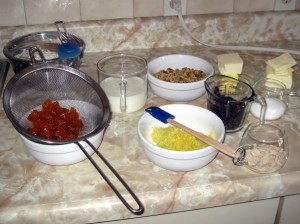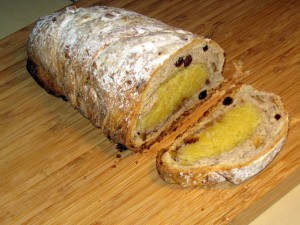 Our recipe is based on Dresden tradition of this wonderful Christmas bread. Crunchy hazelnuts, chocolate chips, red currants and cherries are sometimes added in other regions of Germany or Austria. I find the configuration below very rich already and already very satisfying. The whole process may be long, but, well, you do not do it very often – usually once a year. When you decide to make it, make more than one. The effort will be hugely rewarded!
Our recipe is based on Dresden tradition of this wonderful Christmas bread. Crunchy hazelnuts, chocolate chips, red currants and cherries are sometimes added in other regions of Germany or Austria. I find the configuration below very rich already and already very satisfying. The whole process may be long, but, well, you do not do it very often – usually once a year. When you decide to make it, make more than one. The effort will be hugely rewarded!
Macerating fruit in rum can be done much ahead of time (my German friend chef has a big jar full and ready across the whole winter.)
Rising with yeast will depend on the temperature of the kitchen, and the quality of yeast. The good thing is that you do not have to watch it grow, Cover, leave and check every hour or two.
Stollen can be kept for a long time if well wrapped and stored in a slightly humid, cool place (10-15° C / 50-60° F) – some cellars, for example, or in the basket in the lower part of the refrigerator. It will not last in an overly warm location.
The ingredients below will produce one traditional tiangular German stollen loaf (40cm/16 inch). I usually make twice the recipe and end up with three smaller loaves (each about 28 cm/10.5 inch long), excellent for Christmas gift giving.
- 375 g (2 1/2 to 3 cups) flour
- 175 g (6 oz.) marzipan (home made works very well)
- 175 ml (3/4 c.) milk
- 75 g (1/4 c.) candied lemon and orange peel
- The zest of one lemon
- 75 g (1/4 c.) raisins
- 150 g butter + more for brushing and greasing the baking sheet
- 40 g (2/3 c.) almonds
- 40 g (2/3 cup) walnuts
- a few spoonfuls of rum (or other fruit-based alcohol – I used Nalewka Sliwkowa with excellent results) The amount depends on the volume of your dried/candied fruit – must be enough to almost cover the fruit when macerating
- 50 g. sugar
- 1/2 tbsp. cinnamon
- 1/2 tbsp. nutmeg
- Seeds of 3 cardamom pods, crushed
- 1 packet of dry yeast (18g live yeast)
- 1 beaten egg
- A pinch of salt
- Icing sugar
Preparation
- Combine the fruit, peel and zest with the rum to macerate;
If using live yeast,
- in lukewarm ¼ cup milk gently fold yeast, with 1 tsp of sugar
- set aside for a few minutes in a warm place
- in a bowl, combine the flour, salt, cinnamon, nutmeg and cardamom;
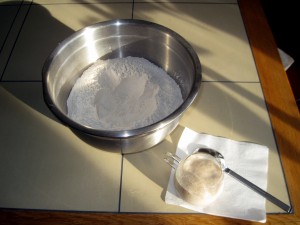
- once the yeast has grown (twice the volume), make a well in the centre of flour mixture,
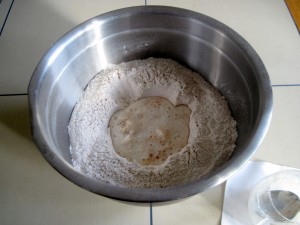 pour in the yeast mixture, cover with flour, leave for a minute or two, until the yeast re-surfaces
pour in the yeast mixture, cover with flour, leave for a minute or two, until the yeast re-surfaces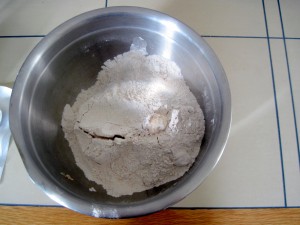
- move to step 9
If using dry yeast
- in a bowl, combine the flour, salt, cinnamon, nutmeg, yeast and cardamom;
- move to step 9
- beat the egg
- place half of the butter, milk and sugar in a small saucepan; heat gently until the sugar is dissolved;
- make a well in the centre; pour the melted butter mixture and the eggs into the well; knead all the ingredients together for 5 minutes to form a smooth, supple dough; if the dough is too sticky, add a little more flour;
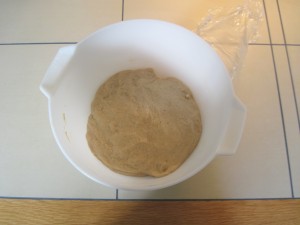
- cover with greased paper and leave to rise for 3 hours, until the dough has doubled in volume
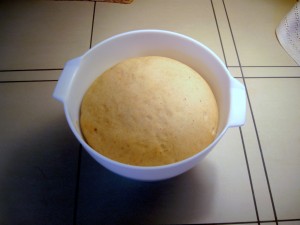
- melt remaining butter
- add melted butter to raising dough
- strain the fruit – if you want you can drink the remaining liquid
- add the macerated fruit, peel, zest and almonds to the dough
- knead again
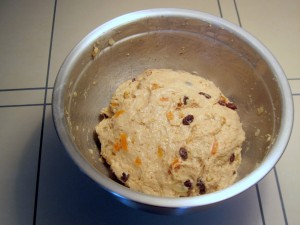
- leave covered for some more time (1-2 hours in my cold kitchen, on the top of the fridge)
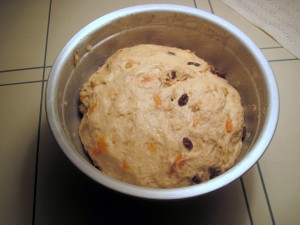
- Set the oven to 190° C (375° F)
- knead the dough again on a floured surface; roll out into a 25 cm (10″) square;
- spread the marzipan over the centre; fold each side over to form a rectangle;
- turn over and place on a buttered baking sheet; cover tightly with aluminum foil (to be removed after some 35-40 minutes)
- place into a preheated oven
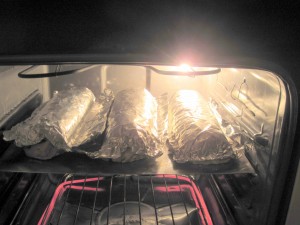 and bake for approximately 50-60 minutes, or until the bread is nicely browned and produces a hollow sound when the bottom is rapped; marzipan insert makes the usual ‘wooden stick’ test not very reliable;
and bake for approximately 50-60 minutes, or until the bread is nicely browned and produces a hollow sound when the bottom is rapped; marzipan insert makes the usual ‘wooden stick’ test not very reliable;
- remove from the oven; brush with melted butter;
 sprinkle with icing sugar.
sprinkle with icing sugar.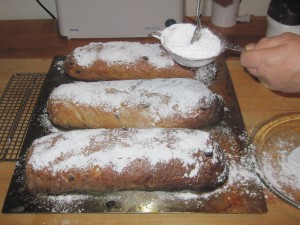
- Allow the loaves to cool completely before you slice and serve them, or before you wrap them very tightly in parchment paper/foil/plastic bags to store in a COOL place… ENJOY!
